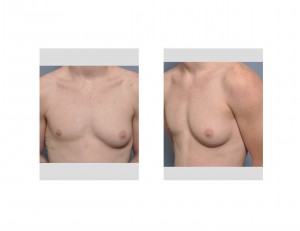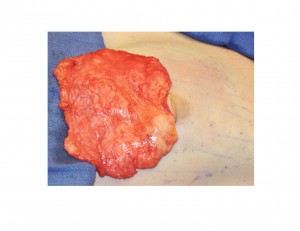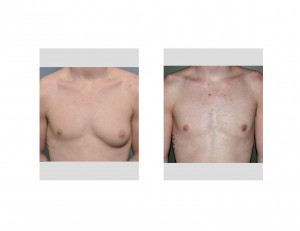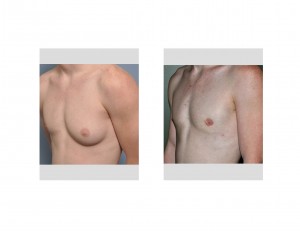Background: Gynecomastia is a well known condition of breast tissue enlargement that most commonly occurs in teenage and young males. Its incidence appears to be increasing in numbers based on surgeries performed for its correction although this may reflect increased awareness of surgical treatment and a fashion trend amongst young men with little tolerance for any areolar protrusion. While historically gynecomastia reduction was more frequently done for one-sided breast enlargement, it is more common today to do bilateral gynecomastia surgery. (perhaps due to the change in young male awareness of a pleasing chest appearance)
Gynecomastia reduction can be done using either liposuction removal or an open excisional approach. In some cases, both techniques are combined for optimal reduction. Which technique is needed can usually be determined before surgery by physical examination. Soft non-nodular gynecomastias can be removed by liposuction, firm masses which are almost right under the nipple-areolar complex which need to be cut out through an areolar incision. The patient’s description of their concerns is also helpful, it is just around the nipple or does it extend over a larger chest area?
The one thing that has become apparent in gynecomastia surgeries in my experience is that open excision is needed more times than not. Even in cases where the breast tissue appears soft there almost always is some nodular tissue right under the nipple. Failure to get this tissue will leave am areolar protrusion afterward that may result in the patient’s desire for revisional surgery for complete flattening. When the enlargement of the breast is mainly nodular, liposuction is not going to be effective at all.




Case Highlights:
1) Large unilateral breast development in young males may represent a single solid tumor rather than simple breast tissue hypertrophy that makes up most gynecomastias.
2) Firm nodular gynecomastias will not respond to liposuction extraction and must be excised by an open technique
3) Excision of even very large solid gynecomastias can be done through a small areolar incision without the need for visible scars on the chest skin.
Dr. Barry Eppley
Indianapolis, Indiana


